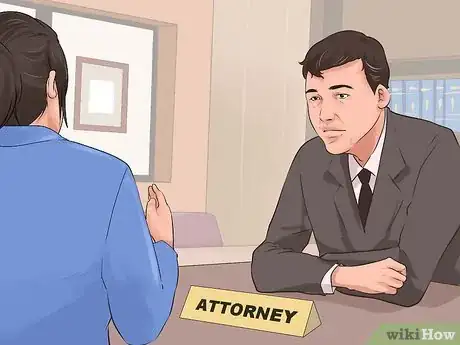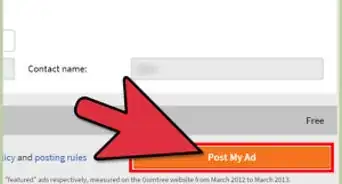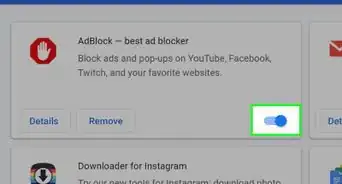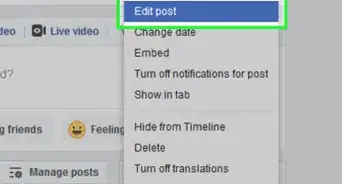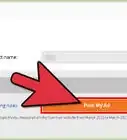This article was co-authored by Clinton M. Sandvick, JD, PhD. Clinton M. Sandvick worked as a civil litigator in California for over 7 years. He received his JD from the University of Wisconsin-Madison in 1998 and his PhD in American History from the University of Oregon in 2013.
There are 14 references cited in this article, which can be found at the bottom of the page.
This article has been viewed 90,313 times.
If you’ve been misled by an advertisement, chances are that you want to find a way to get your money back and save other people from falling for a company’s false claims. Thankfully, reporting false advertising is a straightforward process that anyone can do to help others. In this article, we’ll walk you through how to gather evidence and file a report, plus help you decide whether it’s worth it to sue the company for damages. If you’re ready to stand up to deceptive companies, read on!
Things You Should Know
- Save or copy the misleading ad and contact the company for a refund. Save all communications with them for your report.
- Check the Truth in Advertising website to track down the appropriate state or federal agencies to report the false ads to.
- Consult a lawyer about suing or participating in a class action lawsuit if you suffered consequential damages as a result of the false advertising.
Steps
Preparing a Report
-
1Identify false advertising. False advertising can take many forms. Billboards, TV commercials, and web pop-ups can all be false or misleading. False advertising often involves claims about the health, safety, effectiveness, or cost of goods or services. To quickly check whether the advertising was illegal, see if you can answer “yes” to all three questions:[1]
- Did the ad promise the viewer something?
- Would a “reasonable consumer” be misled by the claim?
- Was the promise something a consumer would find important (that is, was it material to their decision to buy?)
-
2Get evidence. You should try to hold onto evidence of the false advertising. If the advertisement was printed (in a magazine or newspaper), then cut it out. Alternately, you can preserve TV advertisements if you have recorded them.
- If you can't retrieve a pop-up ad, for example, then write down your memory of its contents. Although this is not as ideal as having the pop-up to show to someone, it is the best that you can do.
Advertisement -
3Contact the company for a refund. You can always contact the company and ask for a refund. Call the company (or stop in and visit). You will need your receipt, to either show the sales clerk or to reference when calling. To find a phone number, visit the company's website and look for a contact.[2]
- If the first person you talk to can't help, then request to be connected to a supervisor. Always remain polite yet insistent. Tell whoever you speak to that the product does not work as advertised and that you want a refund.
- Even if you speak to someone on the phone, you should also send a letter. Send it certified mail, return receipt requested so that you will have evidence that it has been received.
- If you don't know what to write, you can use the Federal Trade Commission's sample complaint letter, which is available at https://www.consumer.ftc.gov/articles/0296-sample-consumer-complaint-letter.
- For additional advice on how to get a refund, see Protest and Complain to Receive a Refund.
-
4Preserve communications. If the company responds back in writing, then hold onto the letter. Also hold onto copies of any letters that you send the company. Staple the signed return receipt to your copy of the letter.
- If you talk to someone on the phone, then write down their name and the time of the call. Also summarize the substance of your conversation.
Filing a Report
-
1Find the appropriate federal agency. No single federal agency collects all complaints for false advertising. Instead, you must contact specific federal agencies depending on the type of business you are complaining about. For example, to complain about an airline's false advertising, then you would need to contact the U.S. Department of Transportation.[3]
- By contrast, if you want to report false advertising engaged in by the makers of dietary supplements, then you will need to contact the Federal Trade Commission (FTC).[4]
- The Truth in Advertising website contains a list of industries and links to the appropriate federal agency you should complain to.
-
2Report the advertising to a federal agency. Each agency will ask for different information. You should be prepared to identify the name and location of the company as well as what was false or deceptive about the advertisement.
- If you need to report to the FTC, then visit its website at www.ftc.gov and click on “File a Consumer Complaint.” You will be taken to the FTC's complaint assistant.
- At the assistant, you should select a Category. Most false advertising complaints will fall under “Other.” Click on that category.
- You can then click on the relevant sub-category. To report false advertising in relation to automobiles, then click on that subcategory. If you don't know what subcategory to select, then choose “No Match Found.”
- The complaint assistant will walk you through a series of questions. Provide the information that is applicable. For example, you will be asked how much you paid the company, the method of payment, and the name of any company representative you have contacted.[5]
- If you need to ask questions, you can contact technical support via chat. You can chat between Monday and Friday, 9:00 am to 8:00 pm Eastern Standard Time.[6]
-
3Find your state agency. Every state has an agency that investigates reports of false advertising. In most states, that agency is the Attorney General's Office or a Bureau of Consumer Protection.[7] [8] Many cities also have agencies that investigate allegations of false advertising.
- To find your applicable agency, type “false advertising” or “consumer protection” with your state or city into your favorite web browser.
- The Truth in Advertising website also maintains a listing of state resources, complete with links. You can find this information on their website; search “state-by-state” once at the homepage.[9]
-
4Report to your state or city trade commission. You will need much of the same information that you will need when reporting to a federal agency: the name and location of the business as well as the nature of the false advertising (why is it false?). In New York City, you can report false advertising to the Consumer Assistance division at http://www1.nyc.gov/nyc-resources/service/2911/false-advertising-complaint.
- At the New York City website, you must select the category of business that engaged in the false advertising, e.g., gas station, grocery store, parking garage, etc.
- Provide the “what, where, and who.” In other words, provide details about the false advertising, state the location where it occurred, and then identify the name of the business.[10]
- Be sure to have a copy of the advertisement that you can send to the agency.[11]
-
5Report to the Better Business Bureau (BBB). The BBB was created to collect complaints about false or deceptive advertising. [12] After you file a complaint, BBB will reach out to the business for a response. To contact the BBB, you can visit their website and then type your city and state or your postal code.
- You can then click on “File a Complaint.”
- You will need to answer a series of questions about the business and about yourself. For example, you will be asked whether you are a citizen of the U.S. or Canada and if you are in the military.
- Select “Your complaint involved a: business's advertising” to complain about the false advertising. Then select the business and provide all relevant details about your complaint.
-
6Contact Truth in Advertising, Inc. The truthinadvertising.org (TINA) website collects information about false and deceptive marketing. You can either file a complaint online or download a complaint form. Once you have completed your form, you can send it to TINA in one of two ways:[13]
- You can fax the completed form to (203) 421-6211.
- Also, you can mail the form to Truth in Advertising, Inc., P.O. Box 927, Madison, CT 06443.
Deciding Whether to Sue
-
1Decide if it is worth suing. When a company refuses to refund the cost of the goods or services, then you might want to consider bringing a lawsuit. If you sue, you can generally only recover the amount of money that you lost because of the false advertising. Often, this is only the cost of the product or service that you paid for. When you paid $50 for a clock, then you might not think it is worth your time to bring a lawsuit in order to recover $50.
- There are exceptions. For example, some states grant consumers the power to seek “punitive damages.” Punitive damages are above and beyond the economic loss you suffered and are designed to punish the defendant. Not all states allow punitive damages for false advertising claims. But when a state does, then you might want to bring a lawsuit.[14]
- Furthermore, you might be able to recover for consequential damages caused by the false advertising. For example, if you purchased an over-the-counter medicine but then suffered severe complications from using it, then you could recover for medical bills and any loss of quality of life. This could run into the tens of thousands of dollars and would make a lawsuit worthwhile.
-
2Look for a class action. Many false advertising cases are brought as class actions. A class action allows people who have claims for small dollar amounts to pool together and sue a defendant. Often, the attorneys representing the class work on contingency and take a portion (around 40%) of the money awarded to the class.
- You can search for class actions that are ongoing. Also, some class actions have settled and you will be able to seek reimbursement if you qualify.
- For more information on how to find class actions, you can see Find a List of Class Action Lawsuits.
-
3Contact a lawyer. Only a lawyer can advise you on the details of your state law and whether or not a lawsuit is feasible. The lawyer could direct you to a current class action lawsuit to join. Or the lawyer can review the extent of your damages and recommend that you bring an individual lawsuit.
- To find a consumer protection attorney, you should contact your state's bar association. Most states run lawyer referral programs. You can request the name of a lawyer who has handled false advertising claims before. You can then set up a consultation where you can discuss the merits of your lawsuit.
- Some states allow consumers to recover attorneys' fees if they win the lawsuit. This might make an individual lawsuit even more attractive. If you win, then you won't even have to pay for your lawyer.
References
- ↑ https://www.truthinadvertising.org/is-that-ad-deceptive/
- ↑ https://www.consumer.ftc.gov/articles/0228-solving-consumer-problems
- ↑ https://www.truthinadvertising.org/who-can-you-complain-to-at-the-federal-level/
- ↑ https://www.truthinadvertising.org/who-can-you-complain-to-at-the-federal-level/
- ↑ https://www.ftccomplaintassistant.gov/Details#crnt
- ↑ https://www.ftccomplaintassistant.gov/#crnt&panel1-1
- ↑ https://www.truthinadvertising.org/illinois/
- ↑ https://www.truthinadvertising.org/georgia/
- ↑ https://www.truthinadvertising.org/filing-complaints-at-the-state-level/
- ↑ https://www1.nyc.gov/apps/311universalintake/form.htm?serviceName=DCA+False+Advertising+Gas+Station
- ↑ http://www1.nyc.gov/nyc-resources/service/2911/false-advertising-complaint
- ↑ http://www.whistleblowingprotection.org/?q=node/53
- ↑ https://www.truthinadvertising.org/get-involved/file-a-complaint-2/
- ↑ http://www.nolo.com/legal-encyclopedia/consumer-protection-laws-business-29641.html
- ↑ http://www1.nyc.gov/nyc-resources/service/2911/false-advertising-complaint
About This Article
False advertising is any misleading or incorrect information in an advert that would motivate someone to buy the product or service. To report false advertising, file a complaint with the relevant federal or state agency. The correct federal agency will depend on the industry of the company. Most complaints should go to the Federal Trade Commission but if you had a complaint about an airline company’s advertising, you’d contact the US Department of Transportation. Every state has their own agency for false advertising. So if you want to complain on a state level, find your state’s agency by searching “False advertising” with your state name online. When you file a complaint, tell them the name of the company, where they’re based, and provide evidence of the false advertising. This can be a screenshot, photo, or video recording of the misleading advert. For more tips from our Legal co-author, including how to decide if you should sue a company for false advertising, read on!












